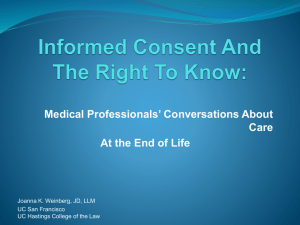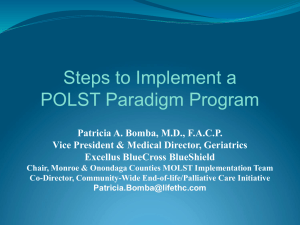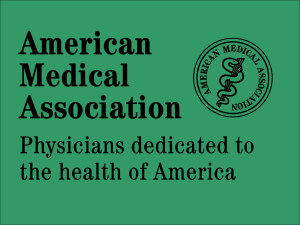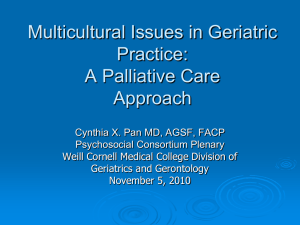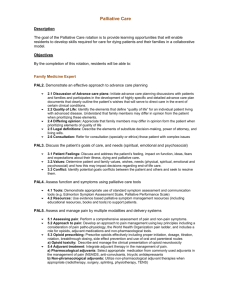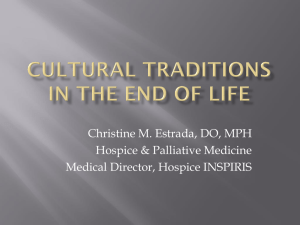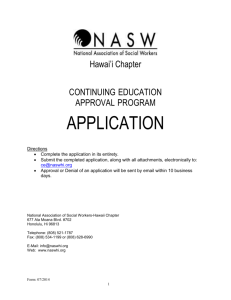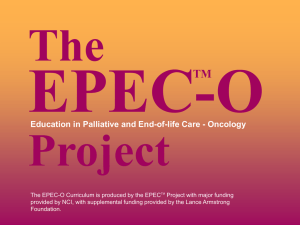End-of-Life Decision Making and Care ISSUE STATEMENT
advertisement
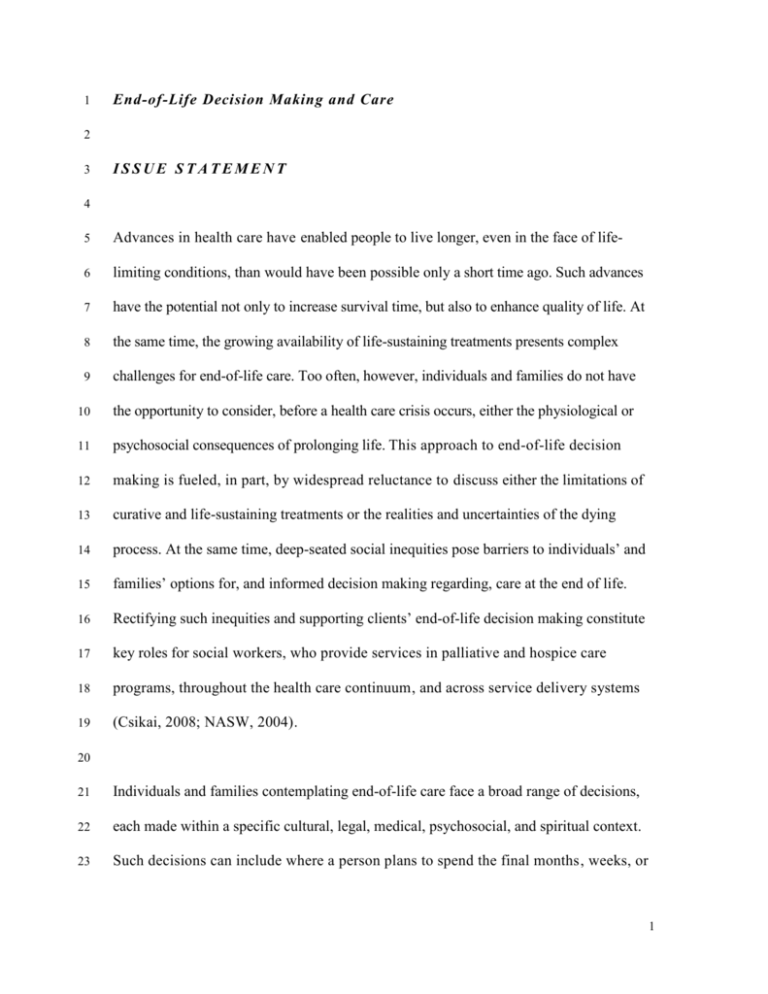
1 End-of-Life Decision Making and Care 2 3 ISSUE STATEMENT 4 5 Advances in health care have enabled people to live longer, even in the face of life- 6 limiting conditions, than would have been possible only a short time ago. Such advances 7 have the potential not only to increase survival time, but also to enhance quality of life. At 8 the same time, the growing availability of life-sustaining treatments presents complex 9 challenges for end-of-life care. Too often, however, individuals and families do not have 10 the opportunity to consider, before a health care crisis occurs, either the physiological or 11 psychosocial consequences of prolonging life. This approach to end-of-life decision 12 making is fueled, in part, by widespread reluctance to discuss either the limitations of 13 curative and life-sustaining treatments or the realities and uncertainties of the dying 14 process. At the same time, deep-seated social inequities pose barriers to individuals’ and 15 families’ options for, and informed decision making regarding, care at the end of life. 16 Rectifying such inequities and supporting clients’ end-of-life decision making constitute 17 key roles for social workers, who provide services in palliative and hospice care 18 programs, throughout the health care continuum, and across service delivery systems 19 (Csikai, 2008; NASW, 2004). 20 21 Individuals and families contemplating end-of-life care face a broad range of decisions, 22 each made within a specific cultural, legal, medical, psychosocial, and spiritual context. 23 Such decisions can include where a person plans to spend the final months, weeks, or 1 24 days before death; supports and services to maximize independence; goals and desired 25 strategies for alleviation of pain and other symptoms; and technological intervention, such 26 as cardiopulmonary resuscitation, mechanical ventilation, and artificial nutrition and 27 hydration, she or he wishes to forego or receive. 28 29 Many people do not communicate their end-of-life care preferences to either their 30 loved ones or health care professionals. Unfortunately, this leaves many family 31 members (both legally recognized family and family of choice) ill prepared to 32 determine the care their loved ones might have wanted. Advance care planning— 33 which includes discussion of end-of-life care choices and documentation of those 34 choices in advance directives—is a key strategy to maximize client self-determination 35 in end-of-life decision making. 36 37 Programs based on the National POLST (Physician Orders for Life-Sustaining 38 Treatment) Paradigm offer individuals another option to direct their end-of-life care. 39 POLST, which is known by different names across states, refers to an individualized, 40 portable set of medical orders to guide treatment of people living with serious or life- 41 limiting illnesses (POLST, 2012). A growing number of states have endorsed 42 programs based on the National POLST Paradigm, and names for such programs vary. 43 This evidence-based paradigm is not intended to replace advance directives; rather, it 44 complements the advance care planning process (Bomba, Morrissey, & Leven, 2011; 45 Pile & Pole, 2013). 46 2 47 The U.S. judicial, legal, and regulatory record regarding end-of-life decision making is 48 complex. During the latter part of the 20th century and the beginning of the 21st 49 century, the cases of Karen Ann Quinlan, Nancy Cruzan, and Terri Schiavo drew 50 national attention to the issue of withdrawing life-sustaining treatment for individuals 51 in a persistent vegetative state. The Patient Self-Determination Act (1990) has 52 mandated that Medicare- and Medicaid-funded health care institutions inquire and 53 provide information about advance directives, and all 50 states and the District of 54 Columbia now have statutes regarding advance directives. Yet, 20 years later, an 55 attempt by the Centers for Medicare & Medicaid Services (CMS) to include advance 56 care planning as a reimbursable service within the newly created Medicare annual 57 wellness visit—a provision for which NASW had advocated—met with such political 58 opposition that the decision was rescinded within days of implementation (National 59 Hospice and Palliative Care Organization, 2011; Pear, 2011). 60 61 In recent years, some states have enacted right-to-know laws, such as California’s 62 Right to Know End-of-Life Options Act (2009) and New York’s Palliative Care 63 Information Act (2010), to ensure that individuals and families receive information 64 about the full range of end-of-life care options legally available within a given state. 65 At the same time, legislation addressing conscience clauses (also known as provider 66 refusal laws) has been considered or passed in a number of states. In such 67 deliberations, NASW cautions that social workers neither discriminate against nor 68 abandon clients in need of professional services (NASW, 2010, 2011). 69 3 70 The issue of physician aid in dying has prompted, perhaps, the greatest controversy 71 regarding end-of-life decision making. Though the first state bill was introduced in 72 Florida in 1967 (Compassion & Choices, 2013b), it was almost 30 years before 73 Oregon became the first state to legalize physician aid in dying with the Death with 74 Dignity Act. The same year Oregon implemented the law, the U.S. Supreme Court 75 ruled (Vacco v. Quill, 1997; Washington v. Glucksberg, 1997) that mentally 76 competent people with terminal illness do not have a constitutional right to physician 77 aid in dying—while upholding the right to pain management, including palliative 78 sedation (Altilio, 2011). These rulings did not prevent states from legalizing physician 79 aid in dying, however. Since that time, Washington, Montana, and Vermont have also 80 legalized physician aid in dying, and initiatives to both legalize and criminalize 81 physician aid in dying are underway in multiple other states (Compassion & Choi ces; 82 2013a; Death with Dignity National Center, 2013). 83 84 In 2001, U.S. Attorney General John Ashcroft filed suit against Oregon to overturn the 85 Death with Dignity Act and stop its proliferation to other states (Oregon v. Ashcroft, 86 2004). Three years later, a federal appeals court ruled against the Attorney General and 87 upheld the Oregon statute. The case proceeded to the Supreme Court, which upheld the 88 Death with Dignity Act in 2006 (Gonzales v. Oregon). NASW, in collaboration with 89 other organizations representing mental health professionals, filed two friend of the 90 court briefs (2002 and 2005) in response to these court challenges. In both briefs, 91 NASW and other members of the Coalition of Mental Health Professionals submitted 92 expert information supporting three positions: 4 93 • Adequate diagnostic tools and protocols are available to assess the mental capacity of 94 a person with terminal illness who desires to hasten death. . . . 95 • A terminally ill patient can be capable of making a reasoned decision to hasten d eath. 96 [The Coalition discouraged use of the term suicide in this context. Accordingly, 97 NASW no longer uses the term physician-assisted suicide.] . . . 98 • Involvement of mental health professionals in situations involving end-of-life 99 decision-making, including serving in the role outline in the ODWDA [Oregon Death 100 with Dignity Act], is considered to be appropriate. (Brief of Coalition of Mental 101 Health Professionals, 2002 [pp. 8, 17, & 24], 2005 [pp. 8, 14, & 22]) 102 103 At the same time, the Coalition of Mental Health Professionals did “not take a position 104 . . . on either the general issue of ‘physician-assisted suicide’ or the more particular 105 issue of the legitimacy of prescribing controlled substances under the ODWDA” (Brief 106 of Coalition of Mental Health Professionals, 2002, p. 3). Rather, the Coalition clarified 107 that provision of mental health “services to individuals considering hastening death 108 does not indicate support for hastening of death itself” (Brief of Coalition of Mental 109 Health Professionals, 2002 [p. 3], 2005 [p. 3]). 110 111 Within the social work profession, a variety of opinions still exists regarding the 112 legalization of physician aid in dying. Recognizing this diversity, and consistent with 113 previous policy statements (NASW, 2003, 2012), NASW neither supports nor opposes 114 legalization of physician aid in dying. In states in which physician aid in dying is legal, 115 however, NASW affirms both the right of individuals to choose this option and the 5 116 responsibility of health care systems and providers to honor clients’ choices, as well as 117 to create and abide by state policies and procedures that prevent abuse of individuals in 118 vulnerable situations. Furthermore, NASW upholds the social work role in clients’ 119 end-of-life decision-making processes and encourages further study, both within and 120 beyond the profession, of the many complex issues associated with physician aid in 121 dying. 122 123 U.S. policy and health care practice concerning end-of-life decision making center on 124 the bioethical principle of respect for individual autonomy (O’Donnell, 2011). This 125 principle dovetails with social workers’ promotion of self-determination, inherent in 126 the profession’s ethical mandate to respect the dignity and worth of every person 127 (NASW, 2008). At the same time, social workers realize that autonomy is not valued 128 equally by all; some people, especially within communities of color and some religious 129 traditions, prioritize family decision making or defer to the will of a divine power 130 (Borgmeyer, 2011; Bressi Nath, Hirschman, Lewis, & Strumpf, 2008; Bullock, 2011a, 131 2011b; del Río, 2010; McCormick, 2011; Wittenberg-Lyles, Villagran, & Hajek, 132 2008). Meanings attributed to concepts such as suffering (Morrissey, 2011) and good 133 death (Ko, Cho, Perez, Yeo, & Palomino, 2013) also vary widely. Moreover, social 134 inequities related to age, disability, gender identity, geography, immigration status, 135 inadequate health coverage, language barriers, poverty, sexual orientation, and other 136 cultural factors differentially affect individuals’ and families’ access to high-quality 137 end-of-life care, thereby diminishing their ability to provide informed consent or 138 refusal when faced with treatment decisions. 6 139 140 Thus, “a one-size-fits-all approach to medical decision making does not work in a 141 multicultural and pluralistic society” (del Río, 2010, p. 145). Consequently, support for 142 clients’ end-of-life decision making entails not only respect for each individual’s right 143 to direct her or his end-of-life care, but also cultural and linguistic competence to 144 ensure maximum participation (NASW, 2007) and advocacy to eliminate health 145 disparities and related injustices (Mackelprang & Mackelprang, 2005). Balancing these 146 tenets in in an environment of cost containment (Jennings & Morrissey, 2011) and in 147 relation to other professions, whose standards and ethics may differ from those of 148 social work (Erlbaum-Zur, 2005), presents challenges for social workers. These 149 challenges notwithstanding, the social work profession remains committed to 150 maximizing knowledge of, and access to, end-of-life care that is congruent with the 151 unique values and goals of each individual, family, and community. 152 153 POLICY STATEMENT 154 NASW promotes respect for dignity, quality of life, and self-determination, as defined by 155 each person approaching the end of life. Accordingly, NASW supports legislation, 156 policies, practices, programs, regulations, and research that promote the following 157 principles and goals related to clients’ end-of-life decision making and care: 158 • consumer education and health care provider communication about the full range of 159 options for end-of-life care and the potential benefits and risks associated with each 160 option 161 • clients’ ability to exercise the full range of legally available options as the end of life 7 162 approaches 163 • equitable access to affordable, comprehensive, person- and family-centered services, 164 including palliative and hospice care, to maximize physical, psychological, social, and 165 spiritual quality of life 166 • sustainable public and private reimbursement for hospice and palliative care, including 167 (but not limited to) the Medicare hospice benefit, services available to Medicaid 168 beneficiaries, and state health insurance marketplace plans 169 • preservation of economic support programs and expansion of residential care and home- 170 and community-based services, including support for family caregivers, to enable people 171 to live and die in their setting of choice 172 • tools and training to facilitate culturally and linguistically appropriate care 173 • multidimensional approaches to prevent and alleviate pain and other symptoms 174 common at the end of life 175 • engagement in a process of advance care planning, with respect for each person’s 176 decision-making capacity, values, and choices 177 • health care providers’ honoring of advance directives, with consideration of each 178 individual’s values and unique medical context 179 • support for the role and responsibilities of health care agents and surrogates 180 • expansion of state programs based on, and education of health care providers regarding, 181 the National POLST (Physician Orders for Life-Sustaining Treatment) Paradigm 182 • continuity of care across service settings, with particular attention to client transitions 183 between health care providers and settings 184 • prevention of client abandonment during transitions of care and in situations in which 8 185 health care providers’ values conflict with clients’ choices 186 • health care provider self-awareness of personal values about dying and death 187 • support for health care providers in coping with professional grief reactions common in 188 end-of-life care 189 • respect for, and integration within interdisciplinary teams of, the multifaceted social 190 work role in end-of-life decision making and care (including social work presence, if 191 requested by individuals or families, at the end of life), in accordance with the NASW 192 Code of Ethics, NASW standards of practice, and state licensure laws and regulations 193 • expansion of social work curricula and research addressing end-of-life care 194 • widespread access to professional development opportunities (including mentoring, 195 supervision, consultation, continuing education, and postgraduate training programs) 196 specific to end-of-life care 197 • continued study and education, both within and beyond the social work profession, to 198 enhance understanding of the complex issues associated with physician aid in dying. 199 200 REFERENCES 201 Altilio, T. (2011). Palliative sedation: A view through the kaleidoscope. In T. Altilio & 202 S. Otis-Green (Eds.), Oxford textbook of palliative social work (pp. 661–669). New 203 York: Oxford University Press. 204 Bomba, P. A., Morrissey, M. B., & Leven, D. C. (2011). Key role of social work in 205 effective communication and conflict resolution process: Medical Orders for Life - 206 Sustaining Treatment (MOLST) program in New York and shared medical decision 207 making at the end of life. Journal of Social Work in End-of-Life & Palliative Care, 9 208 7, 56–82. doi:10.1080/15524256.2011.548047 209 Borgmeyer, T. (2011). The social work role in decision making: Ethical, psychosocial, 210 and cultural perspectives. In T. Altilio & S. Otis-Green (Eds.), Oxford textbook of 211 palliative social work (pp. 615–624). New York: Oxford University Press. 212 Bressi Nath, S., Hirschman, K. B., Lewis, B., & Strumpf, N. E. (2008). A place called 213 LIFE: Exploring the advance care planning of African-American PACE enrollees. 214 Social Work in Health Care, 47, 277–292. doi:10.1080/00981380801985432 215 Brief of amicus curiae Coalition of Mental Health Professionals, Gonzales v. Oregon, 216 546 U.S. 243 (2006). Retrieved from 217 www.socialworkers.org/assets/secured/documents/ldf/briefDocuments/Oregon%20v 218 %20Gonzales%20(ashcroft)%20brief%20final.pdf 219 Brief (No. 02-35587) of the Coalition of Mental Health Professionals as amicus curiae 220 in support of plaintiffs/appellees, Oregon v. Ashcroft, 368 F.3d 1118, 1128 (9th Cir. 221 2004), (No. 02-35587) aff’d sub nom. Gonzales v. Oregon, 546 U.S. 243 (2006). 222 Retrieved from 223 www.socialworkers.org/ldf/brief_bank/searchResults.asp?searchInfo=Oregon+v.+A 224 shcroft&whichSrch=0&searchVal=Oregon+v.+Ashcroft&keyword=Oregon&Submi 225 t=GO%3E 226 Bullock, K. (2011a). Advance directives from a social work perspective: Influence of 227 culture and family dynamics. In T. Altilio & S. Otis-Green (Eds.), Oxford textbook 228 of palliative social work (pp. 625–635). New York: Oxford University Press. 229 230 Bullock, K. (2011b). The influence of culture on end-of-life decision making. Journal of Social Work in End-of-Life & Palliative Care, 7, 83–98. 10 231 232 233 234 235 236 doi:10.1080/15524256.2011.548048 Compassion & Choices. (2013a). In the courts. Retrieved from http://www.compassionandchoices.org/what-we-do/in-the-courts/ Compassion & Choices. (2013b). Timeline. Retrieved from http://www.compassionandchoices.org/who-we-are/timeline/ Csikai, E. L. (2008). End-of-life decisions. In T. Mizrahi & L. E. Davis (Eds.-in- 237 Chief), Encyclopedia of social work (20th ed. Vol. 4, pp. 138–141). Washington, 238 DC, and New York: NASW Press and Oxford University Press. 239 Death with Dignity Act, 3 Ore. Rev. Stat. §§ 127-800-995 (1994–1999). 240 Death with Dignity National Center. (2013). Death with dignity around the U.S. 241 Retrieved from http://www.deathwithdignity.org/advocates/national 242 del Río, N. (2010). The influence of Latino ethnocultural factors on decision making 243 at the end of life: Withholding and withdrawing artificial nutrition and hydration. 244 Journal of Social Work in End-of-Life & Palliative Care, 6, 125–149. 245 doi:10.1080/15524256.2010.529009 246 Erlbaum-Zur, P. (2005). Attitudes of long-term care social workers toward physician- 247 assisted-suicide. Journal of Social Work in Long-Term Care, 3, 175–197. 248 doi:10.1300/J181v03n03_12 249 Gonzales v. Oregon, 546 U.S. 243 (2006). 250 Jennings, B., & Morrissey, M. B. (2011). Health care costs in end-of-life and palliative 251 care: The case for ethical reform. Journal of Social Work in End-of-Life & Palliative 252 Care, 7, 300–317. doi:10.1080/15524256.2011.623458 253 Ko, E., Cho, S., Perez, R. L., Yeo, Y., & Palomino, H. (2013). Good and bad death: 11 254 Exploring the perspectives of older Mexican Americans. Journal of Gerontological 255 Social Work, 56, 6–25. doi:10.1080/01634372.2012.715619 256 Mackelprang, R. W., & Mackelprang, R. D. (2005). Historical and contemporary issues 257 in end-of-life decisions: Implications for social work. Social Work, 50, 315–324. 258 McCormick, A. J. (2011). Self-determination, the right to die, and culture: A literature 259 review. Social Work, 56, 119-128. Retrieved from 260 http://www.biomedsearch.com/article/Self-determination-right-to-die/254311527.html 261 Morrissey, M. B. (2011). Phenomenology of pain and suffering at the end of life: A 262 humanistic perspective in gerontological health and social work. Journal of Social 263 Work in End-of-Life & Palliative Care, 7, 14–38. doi:10.1080/15524256.2011.548045 264 National Association of Social Workers. (2003). Client self-determination in end-of-life 265 decisions. Social work speaks: National Association of Social Workers policy 266 statements, 2003–2006 (6th ed., pp. 46–49). Washington, DC: NASW Press. 267 National Association of Social Workers. (2004). NASW standards for palliative & end of 268 life care. Retrieved from 269 http://www.socialworkers.org/practice/bereavement/standards/standards0504New.pdf 270 National Association of Social Workers. (2007). Indicators for the achievement of the 271 NASW standards for cultural competence in social work practice. Retrieved from 272 http://www.socialworkers.org/practice/standards/NASWCulturalStandardsIndicators20 273 06.pdf 274 National Association of Social Workers. (2008). Code of ethics of the National 275 Association of Social Workers. Washington, DC: Author. Retrieved from 276 http://www.socialworkers.org/pubs/code/default.asp 12 277 National Association of Social Workers. (2010, May). Social workers and conscience 278 clauses [Legal Issue of the Month]. Retrieved from 279 http://www.socialworkers.org/ldf/legal_issue/2010/201005.asp 280 National Association of Social Workers. (2011, May). Provider refusal and conscience 281 clause controversies [Legal Issue of the Month]. Retrieved from 282 http://www.socialworkers.org/ldf/legal_issue/2011/052011.asp?back=yes 283 National Association of Social Workers. (2012). End-of-life care. Social work speaks: 284 National Association of Social Workers policy statements, 2012–2014 (9th ed., pp. 116– 285 122). Washington, DC: NASW Press. 286 National Hospice and Palliative Care Organization. (2011, January 4). Hospice community 287 disappointed in administration’s decision and reminds all Americans of the value of 288 advance care planning [Press release]. Retrieved from http://www.nhpco.org/press- 289 room/press-releases/medicare-eol-consult 290 O’Donnell, P. (2011). Ethical considerations in palliative care: An overview. In T. Altilio & 291 S. Otis-Green (Eds.), Oxford textbook of palliative social work (pp. 605–613). New 292 York: Oxford University Press. 293 294 Oregon v. Ashcroft, 368 F.3d 1118, 1128 (9th Cir. 2004), (No. 02-35587) aff’d sub nom. Gonzales v. Oregon, 546 U.S. 243 (2006). 295 Palliative Care Information Act, 331 NY Public Health Law § 2997-C (2010). 296 Patient Self-Determination Act, 42 U.S.C. §§ 1395i-3, 1395l, 1395cc, 1395mm, 1395bbb, 297 298 299 1396a, and 1396r (1990). Pear, R. (2011, January 4). U.S. alters rule on paying for end-of-life planning. The New York Times. Retrieved from 13 300 http://www.nytimes.com/2011/01/05/health/policy/05health.html?partner=rss&emc=rss&_ 301 r=0 302 Pile, C., & Pole, L. (2013, Spring). Virginia POST: Improving patient-physician 303 communication about end of life care. Age in Action, 28(2). Retrieved from 304 http://www.sahp.vcu.edu/vcoa/newsletter/ageaction/agespring13.pdf 305 POLST: Physician Orders for Life-Sustaining Treatment Paradigm®. (2012). About the 306 national POLST paradigm. Retrieved from http://www.polst.org/about-the-national- 307 polst-paradigm/ 308 Right to Know End-of-Life Options Act, Cal. Health and Safety Code §§ 442–442.7 (2009). 309 Vacco v. Quill, 521 U.S. 793 (1997). 310 Washington v. Glucksberg, 521 U.S. 702 (1997). 311 Wittenberg-Lyles, E., Villagran, M. M., & Hajek, C. (2008). The impact of 312 communication, attitudes, and acculturation on advance directives decision-making. 313 Journal of Ethnic & Cultural Diversity in Social Work, 17, 349–364. 314 doi:10.1080/15313200802467874 14
